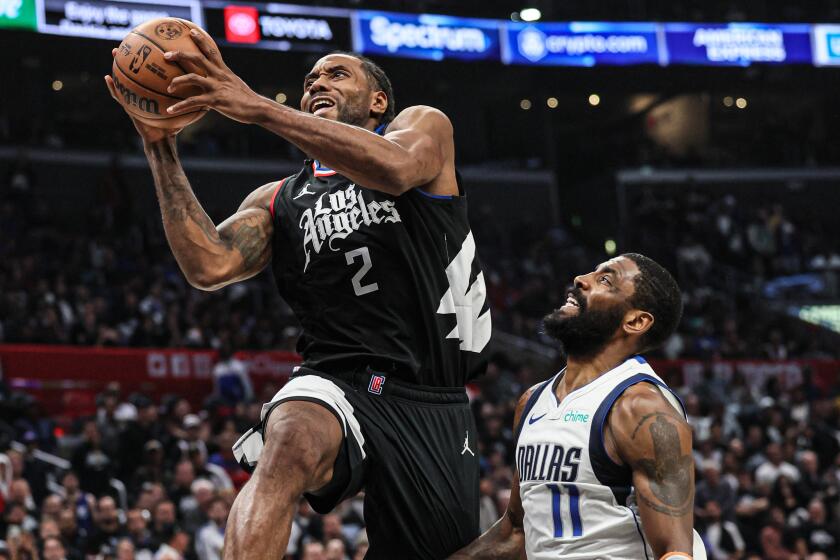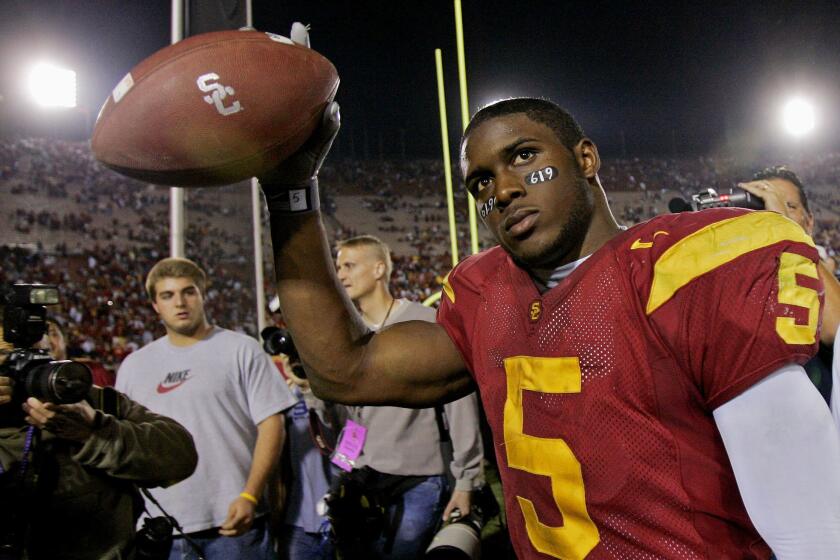A League With 8 Divisions
The most pressing business facing the NFL today is realignment, which, when completed in the next several months, will spread 32 pro clubs through eight separate but hopefully equal four-team divisions.
Only one uncertainty remains: the precise membership of each division.
Although a new arrangement of teams is obviously necessary, many ownerships are resisting any change in their present traditional rivalries.
So how should the NFL proceed?
I’d say there are two things to do:
Name a committee of club owners to compile the 10 or 12 best proposals for a competitive eight-division league.
Hire independent auditing experts to (a) toss the proposals in a hat and (b) draw out the winner.
No Agreement on Realignment
In the days when Pete Rozelle was the league’s commissioner, he accomplished realignment by asking his private secretary to haul the winning proposal out of a hat--but these are more suspicious times.
Hall of Fame and Academy Awards leaders are among those now preferring independent auditors.
In any case, a hat lottery of some kind will be needed to realign the NFL because the 32 rich, proud owners are unlikely ever to agree on any single proposal.
Their extraordinarily diverse interests preclude agreement.
Small Divisions, Fewer Losers
The history of pro football suggests that most traditional rivalries aren’t born, they’re created.
For one example, the Dallas-Washington game was just another game until a Redskin coach, George Allen, made it into a rivalry in the 1970s.
The key to a successful sports league is competitive balance--which over time will produce plenty of traditionals.
Nor are geographical groupings important.
Pro football critics have for years been confused about that.
Geographical labels--NFC West, AFC Southeast, etc.--arose because, and may well be continued because, that’s the simple way to do it.
If at the same time New Orleans, say, continues in the NFC West, the reason should be: That’s the competitive way to do it.
One other potential stumbling block to proper realignment is the recommendation, often heard, for eight-team rather than four-team divisions.
In an eight-team division, there are too many losing teams: six of them every year along with a champion and a runnerup.
Logic is on the side of a four-team design, which annually creates, in each division, a champion and runnerup but only two losers.
Colts Could Play Like Rams
Through their bye week, the undefeated St. Louis Rams continued as the most admired team in football--but not, strangely, the model.
In New England the other day, the Indianapolis Colts again declined an opportunity to join the Rams as a wide-open winner.
In a 24-16 upset, the Patriots beat one of the NFL’s fine passers, Peyton Manning, on a day when the Indianapolis quarterback could have and should have won easily.
Manning’s problem was that his coaches grounded him unnecessarily on the game’s decisive plays: the many first-down plays in the first three quarters when the conservative Colt chief, Jim Mora, ordered not passes by Manning but runs by Edgerrin James.
Although Manning’s great talent is similar to that of Ram passer Kurt Warner, how can he show it handing the ball away?
On Ram Coach Mike Martz’s orders, Warner gets off the bus throwing--and KEEPS throwing--which is the secret to wide-open football.
In New England by contrast, the Colts played into the hands of the new coach there, Bill Belichick, who on first-down plays met James with an eight-man line.
On most other downs, Belichick shifted to pass defenses, which drove Manning out of a Warner kind of day.
Clearly, Mora hasn’t a clue to what Martz and Warner are up to.
Skins Could Play Like Rams
On the day that Manning’s conservative coaches brought him down in New England, the Washington Redskins struggled for identical conservative reasons to overcome an even weaker team at Philadelphia in overtime, 17-14.
The Redskin coach, who was a brilliant signal-caller several years ago as Jimmy Johnson’s offensive coordinator in Dallas, is now playing simply not to lose.
That is, like Mora and the NFL’s other conservatives, Turner keeps trying to establish the run.
Like Mora, he has a good runner, Stephen Davis, but Davis learned in Philadelphia what James was simultaneously learning in New England: namely that the odds are against any runner on first-down plays against an eight-man front.
The irony was that Washington passer Brad Johnson, who like Manning has much of Warner’s ability, kept converting with passes on second and nine, third and 12, third and nine, second and eight and other passing downs--when the Eagles frequently faced him helplessly in pass defenses.
A passer who can do that--who can convert on third and 12--can have a field day throwing on first and 10.
Had Turner allowed his quarterback to open up with throws on first down and other running downs--when the Eagles often piled up Davis near the scrimmage line--the Redskins might have achieved a Ram-like victory.
Raiders Could Play Like Rams
Still another potential passing power, Oakland, struggled in San Francisco on the same day for the same reason, winning only in overtime, 34-28, after Raider Coach Jon Gruden grounded passer Rich Gannon on most early-game, first-down plays, when the Raiders sought to run the ball with Tyrone Wheatley.
In the overtime period, football fans saw what Gannon can do when he whisked a perfect pass to Tim Brown on the winning 31-yard touchdown play that finally disposed of the improving 49ers and their improving quarterback, Jeff Garcia, a player who deserved to win and would have won if his side could execute the old field-goal play.
For much of the game, Gruden, like Turner, was coaching not to lose.
Thus, typically, after the Raiders blocked a first-half punt, Gruden called running plays on first and second down, then a desperation third-down pass, and then a field goal which raised the score to 6-0 at a point when it should have been 14-0.
What we’re talking about here is a group of three NFL teams that all have good offensive talent--Oakland, Washington, Indianapolis--and that all have good passers: Gannon, Johnson, Manning.
All three teams should have overwhelmed their opponents that day.
All three should have looked like and achieved like the Rams.
All three were hamstrung by conservative play-calling--the precise nonsense that the high-scoring Rams eschew.
Martz: A Man of Mystery
The most incongruous thing about the NFL at the moment is that nobody seems to know how the Rams, extending a trend they began a year ago, have been scoring all those points.
Nobody seems to know what the leaders of the Rams, Martz and Warner, are really doing over there in St. Louis.
Nobody in the NFL.
No critics, no fans, no announcers.
Not even John Madden.
At the same time, everybody in and near the league is talking about the Rams.
Everyone says how remarkable they are, how fast, how high-scoring, how offensive.
Still, nobody seems to understand what they’re doing--or how they’re doing it.
If the NFL’s other coaches understood--if Gruden and Mora and Turner could really see what’s going on in Ram films and tapes---they’d do the same things.
Wouldn’t they?
Isn’t it better to win with ease than with difficulty?
Isn’t it true that football coaches are sheep who follow any winning leader, doing and saying the same things the winner does?
People who don’t like coaches say so.
But plainly, that isn’t the case.
Plainly, Martz remains a mystery to his peers.
And the curious thing about it is that on the Ram team, Martz’s philosophy, if ultra-bold, seems simple enough.
As simple as it is startling.
At gametime, this, in part, is what the Rams appear to be doing:
They pass all the time.
Habitually, they throw on first down--as the first mainline NFL team that ever did.
When, on occasion, they do run, they seem to be setting up a pass play.
They ignore the Even-Steven pass-run ratio demanded in recent years by all other good teams.
The only ratio they seem to be interested in is passes-points.
In many formations, the Rams use both a fullback and a running back, thus providing a conventional running-play look that holds their opponents in a partial run-defense mode while they throw the ball.
They throw often both to the running back, Marshall Faulk, and fullback, Robert Holcombe, as well as two or three wide receivers and one or two tight ends.
Their lineup, in a word, is conventional--but not their strategy.
Even though Faulk is a feared ballcarrier, he almost never pounds into the line on first down--the way Tyrone Wheatley, Stephen Davis and Edgerrin James pounded the ball for Oakland, Washington and Indianapolis the other day.
Martz obviously calls on Faulk the runner, as distinct from Faulk the receiver, only when the opposing team is geared for a pass play.
In effect, therefore, Warner is typically throwing Ram passes against run defenses--as on first down--and Faulk is typically coming out of the backfield as a ballcarrier only against pass defenses.
Every move the Rams make is made at top speed--from throw to catch and everywhere in between--meaning that you don’t have to BE a sprinter to play for Martz, just play like one.
The Rams use the whole field, sending at least one receiver very deep and one very wide on every pass play, thus stretching the playing surface in both directions in order to throw mainly mid-range passes.
Inside their opponents’ 20-yard line, the Rams lose the advantage of the deep receivers, thereby enabling the other team to compress its defenses, thereby restricting Ram red-zone effectivness.
The player Martz lacks--if it’s a lack--is a huge, hard-running back to hack out red-zone yardage.
But when you throw the ball on every play, you’re rarely in the red zone.
You leapfrog the red zone with passes.
The key is throwing on virtually every play.
More to Read
Get our high school sports newsletter
Prep Rally is devoted to the SoCal high school sports experience, bringing you scores, stories and a behind-the-scenes look at what makes prep sports so popular.
You may occasionally receive promotional content from the Los Angeles Times.






